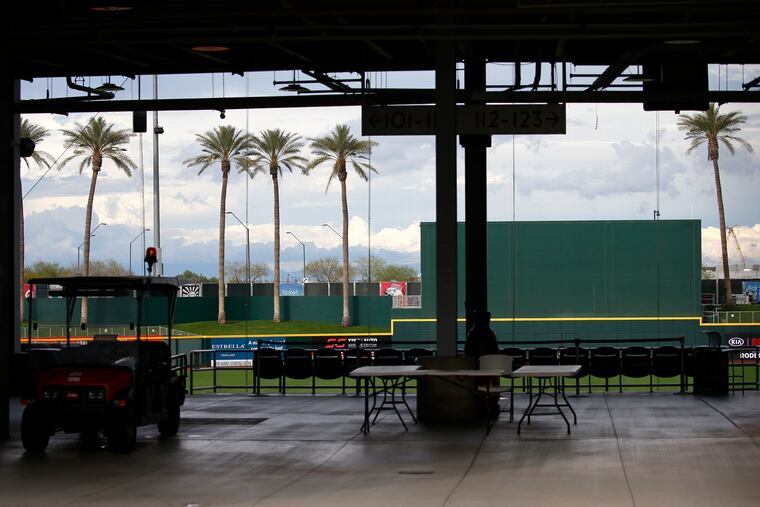Phillies home games in the Arizona desert? No thank you, MLB | Bob Brookover
MLB is discussing the idea of beginning its regular season with all teams playing in Arizona without fans. It's a bad idea for a lot of reasons.

The players want to play and that’s understandable. They have a lot at stake here. The amount of money they stand to lose if the baseball season is cut in half or wiped out completely is astronomical.
Bryce Harper, for example, will be paid roughly $300,000 this season if the Phillies do not play a game. That’s part of the $170 million advance agreement the owners and players made for the months of April and May, which almost certainly are going to be lost to the COVID-19 shutdown. Harper was supposed to make $27.5 million this season.
He, of course, can survive based on the $70 million or so he has already made in his career. Things will not be quite as easy for a player like Kyle Garlick, who will likely get a $30,000 piece of the pie for April and May. That’s better than the government stimulus deal, but probably not enough to get him through the winter.
The owners want to play and that’s also understandable. According to Forbes, the Phillies had $341 million in revenue last season and $94 million in operating income, which was the second-highest in baseball. Only those with access to the accounting figures know how accurate those numbers are, but it can be said with absolute certainty that the loss of a season would be a devastating hit even for a franchise valued by Forbes at $1.85 billion.
There is no way to make up all of that revenue for the players and the owners this season, but the two sides are trying hard to figure out some way to hold onto a portion of it. A story surfaced Monday night that the idea of playing the regular season in Arizona without fans is on the table.
Scott Boras, the agent for Harper and a large stable of baseball’s superstars, loves the idea.
“It allows for immediacy of a schedule, where you might be able to begin it and televise it, provide Major League Baseball to America,” Boras told the Associated Press. “I think players are willing to do what’s necessary because I think they understand the importance of baseball for their own livelihoods and for the interest of our country and providing a necessary product that gives all the people that are isolated enjoyment. It gives them a sense of a return to some normalcy. You talk to a psychologist about it and they say it’s really good for a culture to have sport and to have a focus like that, where for a few hours a day they can take their minds off the difficult reality of the virus.”
Sorry, but there would be nothing normal about watching the Phillies play the New York Mets or Atlanta Braves in an empty spring-training ballpark in Arizona, and it’s definitely not enough to take our minds off what is happening in the real world. Players crushing baseballs and throwing 95 to 100 miles per hour are what draws the fans to the ballpark, but the theater is not even close to the same if no one is in attendance to appreciate it. There’s a reason 19 teams had a winning record at home and only 12 had a winning record on the road last season. The players get an adrenaline kick out of playing in front of their home crowd.
Argue if you want that something is better than nothing, but is it really?
LeBron James understands that the game is not the same without its fans in attendance.
“There’s no excitement,” the NBA’s preeminent star said during a recent podcast with some of his former Cleveland Cavaliers teammates. “There’s no crying. There’s no joy. There’s no back-and-forth.”
The Arizona plan is flawed in other ways, too. The average high temperature in Phoenix is 102 degrees in June, 104.2 in July and 102.4 in August. Just as an example, the final game of the Arizona League playoffs was played on Aug. 30 last season. The starting time was 6 p.m. The temperature was 113 degrees.
Pick any day from that low-level rookie league’s season and it’s a good bet the temperature was in triple digits when the game started. And if you’re starting at 6 p.m. in Phoenix, it’s 9 p.m. on the East Coast. Fans can stomach a couple West Coast trips a year. A season filled with them, on the other hand, is not at all appealing. There is no good starting time in the desert for East Coast TV unless you’re willing to play in the most intense heat of the day. Trust me, 115-degree heat does not feel that dry.
Playing the games so the players can be paid and the owners can get their television money is not a good enough reason to start the season. A big part of the reason we all want to see baseball again is to help the gameday employees collect their paychecks again. Many of them count on that money. Games in Arizona will not help them.
Look, we all want baseball back and if they want to play split doubleheaders to make up for lost days and lost revenue, that’s fine. But the games only matter if they are being played in front of the people who care about them the most. And those people are the ones who are willing to dip into their bank accounts to go to the games. The owners and players would be wise to wait for that time when they can attend games again.